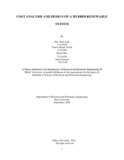Cost analysis and design of a hybrid renewable system
Abstract
Development of off-grid small hybrid solar-hydro-wind energy generation system for application in remote area is one of the essential projects to promote sustainable development in Bangladesh. The proposed hybrid solar-hydro-wind system in a proposed bio-diversity center in Chittagong Hilly Area is sited on around 120-hectares of secondary and primary forest is a veritable fount of biological & ecological knowledge, with the area’s fauna and flora extensively studied and documented. The centre offers two dormitories, a teaching centre consisting of a classroom-laboratory as well as a VIP suite and two self-contained chalets as residences for visiting researchers from abroad. A favorite research centre for foreign researchers conducting biological and ecological studies, the site is also popular with geology students and is an excellent training ground for students to experience their first fieldwork practice. Additionally, the centre is also open to school children who want to experience the wonder of nature. The three renewable sources, which are going to be hybridized, are the solar, wind and the Pico hydropower. The hybrid system is composed of a variety of components, which include the photovoltaic modules, wind turbine, hydropower generator and a control system, which together form the entire system capable of supplying electric power Solar energy is obtained from the solar panel and the Pico hydropower is obtained from the Pico hydro power plant. The power from the solar panel, which is in dc form is converted by using suitable inverters. On the other side, the power from the Pico hydro turbine, which is in ac form. This output is given to the load through the switches.

